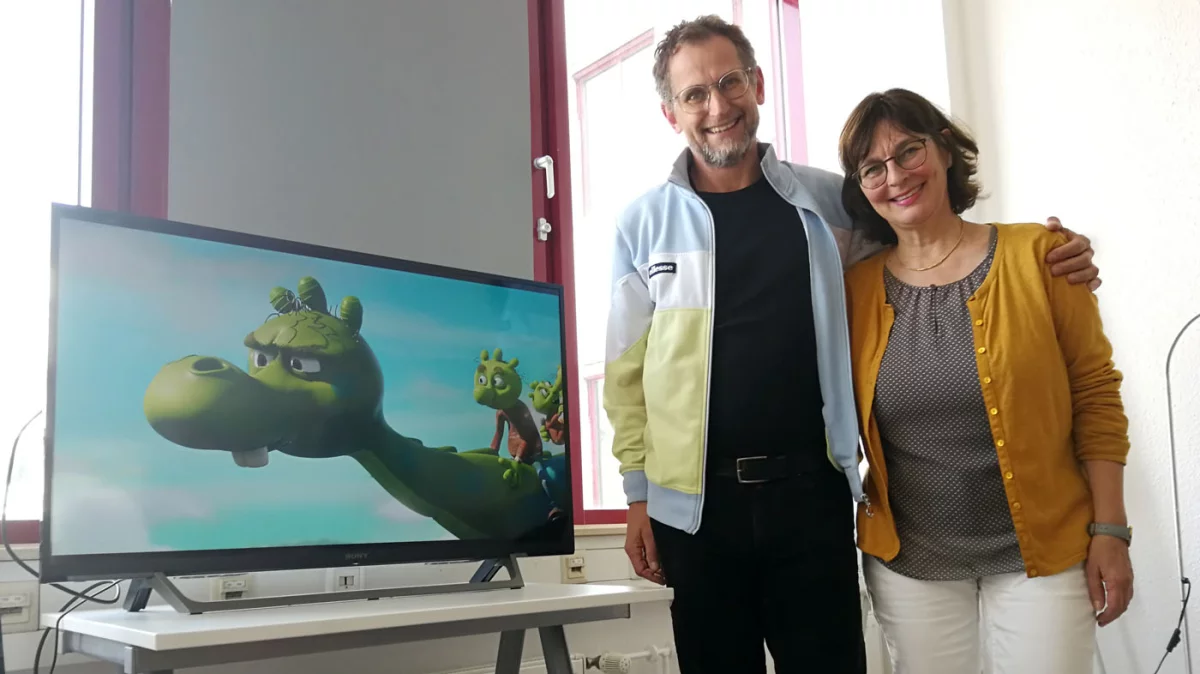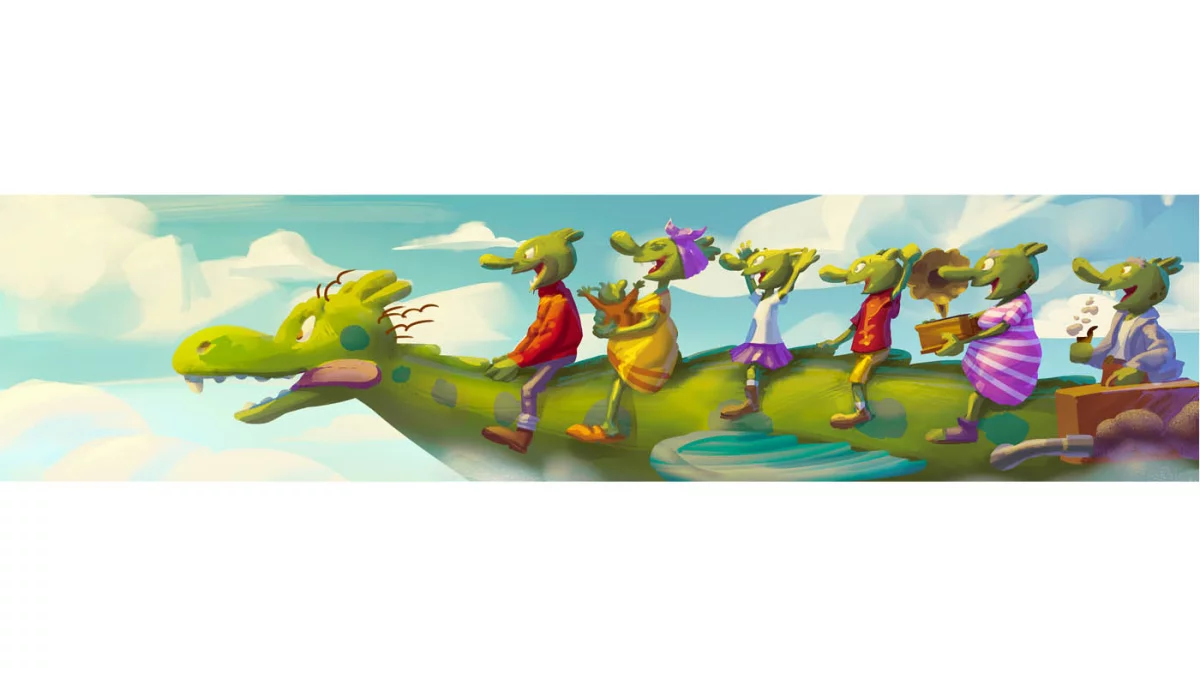
Welcome to Schmuddelfing
12.06.2019 | The Olchis are coming to the cinema
They are small, green and love to eat their own rubbish. The Olchis have now achieved cult status in German children's rooms, and in 2020 they are coming to the big screen with the help of Hamburg production company WunderWerk. Directors Jens Møller and Executive Producer Sunna Isenberg talk to us about the development of the look, the meta-levels of the film - and why there is less burping in the English version.
The Olchis are finally coming to the big screen in 2020. How long have you been working on the material?
Sunna Isenberg: It was well over ten years ago when the publisher Friedrich Oetinger came to us with the idea for the film. At that time, the Olchis were already very well known - but the rights were initially assigned elsewhere. However, the right approach for a cinematic realisation could not be found at that time. There is one thing you need to know about the Olchis: they are very relaxed and never have any problems. Bad prerequisites for the dramaturgy of a cinema film. In addition, of course, you always have to make sure that you don't change the brand - in our case the Olchis - too much through the film format. The rights were then released again at some point and so the Olchis found their cinematic home with us. In 2016, John Chambers' script won the Animation Screenplay Award in Stuttgart, which gave the project a major boost. We've been working flat out on it ever since.

What did you have to change to make the Olchis from the original novel fit for the big screen?
Sunna Isenberg: When adapting book illustrations into film images, you always have to adapt the look of the characters a little so that they look fresh and modern on the big screen. From the very beginning, it was important to us that the Olchis' extraordinary, endearing nature was also reflected in their appearance in our CGI film. Of course, you also have to consider the viewing habits of children today. The look development for the 3D characters was really complex, but it was worth it.

Toby Genkel accompanied the "The Olchis" project as Director for a long time - Jens Møller took over his position in July 2018. How did this come about?
Sunna Isenberg: Toby Genkel had already been working on the Olchis for a long time at that time and then had to devote himself to other projects due to his contract. He was in charge of pre-production and also co-wrote the script. So at the end of the pre-production phase, we had to start looking for a new Director - and in Jens Møller we found someone whose vision matched Toby's. He brought a lot of international expertise to the table. He had a lot of international expertise, had already directed series such as Benjamin Blümchen and Bibi Blocksberg in Copenhagen and had worked on huge projects such as Lego Star Wars for Disney. So it wasn't a difficult choice. Jens and Toby worked together on the project for a good two months - so it was a smooth transition and Toby was able to let the project go with peace of mind.
Jens Møller: The coordination with Toby went really well. The project was at a good point to do a handover between us Directors.
What were the most labour-intensive steps during the making of the film?
Sunna Isenberg: From a producer's point of view, I think the most labour-intensive step is financing a film. You have to work with different studios and sponsors from different parts of the country and abroad - as in the case of the Olchis with Belgium. That requires a lot of coordination.
Jens Møller: For the Directors, every work step is intense. (laughs) A large part of the design and preparatory work took place in Hamburg, this is where we keep the threads together. I am also currently supervising the work that is currently taking place in Wiesbaden, Frankfurt, Stuttgart and Ghent from here. We are currently shading, texturing and colouring so that the figures in 3D have the right look later on.
Sunna Isenberg: The animation process is also already underway and the Olchis have come to life. When the Olchis took their first real steps, I actually shed a tear - after so much preparation time, it was a milestone.

Jens, what story did you want to tell with the Olchis or what was your vision?
Jens Møller: I didn't know the Olchis before, I didn't grow up with them as I was born in Denmark. So the question for me was how to tell the story as entertainingly as possible in cinema format. The immigration aspect was also very important to me. In the film, the Olchis arrive in a new culture, a new town. But the inhabitants don't want them there because they are too different and too funny. A more than topical issue that we are confronted with every day in our society. The film takes a very humorous look at how people can live together and learn from each other despite initial doubts. Alongside the kids, the mayor's wife has clearly emerged as one of the main characters. She undergoes a major transformation during the film.
Is she your favourite character?
Jens Møller: She plays an important part in the story and is a very interesting character for me. She is a businesswoman and wants more tourists to come to Schmuddelfing. She first has to learn that a lot of things are already going well the way they are. For me, however, the scenes between the Olchis and the villagers are clearly the real star of the story.
Sunna Isenberg: Yes, absolutely - the Olchis are the absolute heroes of our adventure!

The film is about a smelly city - to what extent did you deal with the topics of "sustainability" and "environmental protection"?
Jens Møller: Of course, these are topics that we also address in the film on a meta-level - we show what people do to nature. The Olchis, on the other hand, eat their rubbish and simply dispose of it themselves. So the film is also a bit political - but in a very entertaining, child-friendly way. That wasn't planned at the beginning and only crystallised bit by bit.
Sunna Isenberg: Of course, we are not making an "explanatory film" about environmental protection. The Olchis are real family entertainment. The important topic of sustainability is therefore conveyed subtly rather than taking centre stage. But I think that children and adults will come away from the film with stimulating thoughts - also on this topic.
So are the Olchis a good role model?
Jens Møller: I think they are a good role model for us in many ways - especially from a social point of view. We often worry about the wrong things, or generally worry too much. We should be a bit more relaxed and all have a good time together.
Sunna Isenberg: The Olchis are like a big Italian family, with different generations living under one roof. They always eat together and generally enjoy being together and helping each other. Maybe that's why the kids like them so much
The Olchis love to burp and fart. Is it true that you had to cut out some sounds in other countries?
Sunna Isenberg: That's actually true. Because there is a large fan community in Germany that loves it when the Olchis burp and fart. So they do it now and again in the German version. In the international version, however, they are unlikely to do so because distributors are more reluctant to read such scenes in the script.
The Olchis aren't exactly very tidy - how are things at home for you, Jens?
Jens Møller: I'm not an Olchi, but I'm not super clean either. But of course I take out the rubbish and don't eat it. (laughs) Besides, I'm hardly ever at home - so I only have to wipe off the dust on the furniture from time to time.
more articles






.jpg?fit=max&w=800&h=1066&q=90&fm=webp)
